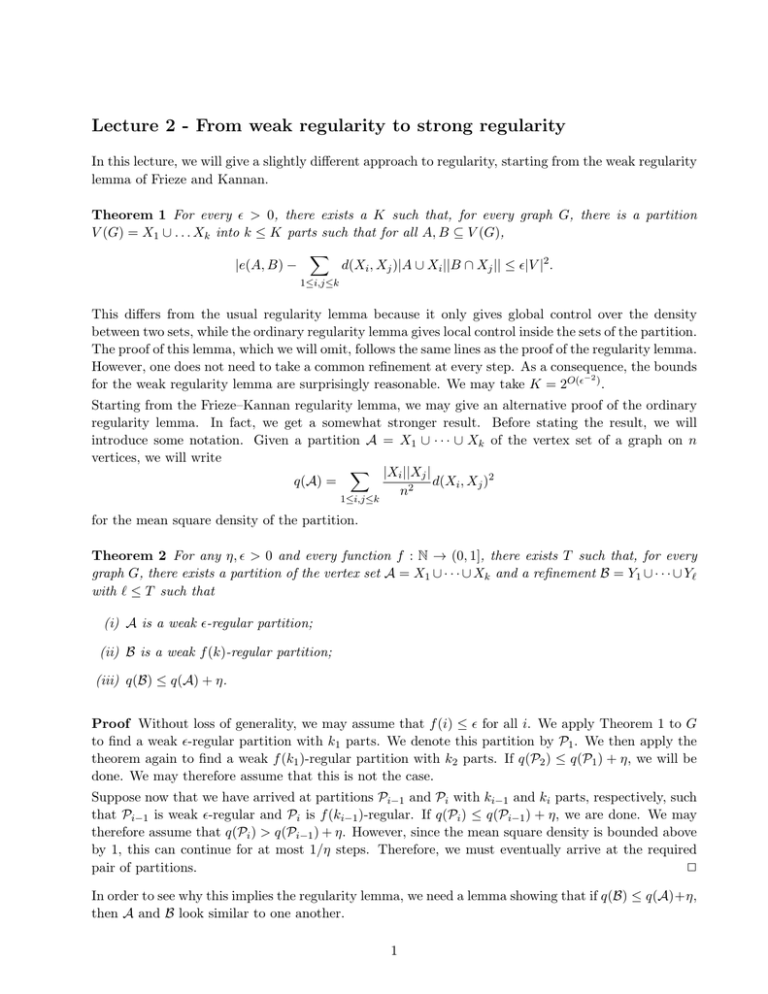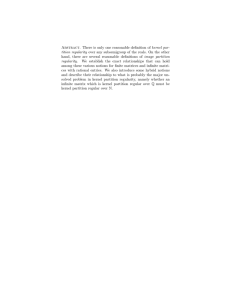Lecture 2 - From weak regularity to strong regularity
advertisement

Lecture 2 - From weak regularity to strong regularity
In this lecture, we will give a slightly different approach to regularity, starting from the weak regularity
lemma of Frieze and Kannan.
Theorem 1 For every > 0, there exists a K such that, for every graph G, there is a partition
V (G) = X1 ∪ . . . Xk into k ≤ K parts such that for all A, B ⊆ V (G),
X
|e(A, B) −
d(Xi , Xj )|A ∪ Xi ||B ∩ Xj || ≤ |V |2 .
1≤i,j≤k
This differs from the usual regularity lemma because it only gives global control over the density
between two sets, while the ordinary regularity lemma gives local control inside the sets of the partition.
The proof of this lemma, which we will omit, follows the same lines as the proof of the regularity lemma.
However, one does not need to take a common refinement at every step. As a consequence, the bounds
−2
for the weak regularity lemma are surprisingly reasonable. We may take K = 2O( ) .
Starting from the Frieze–Kannan regularity lemma, we may give an alternative proof of the ordinary
regularity lemma. In fact, we get a somewhat stronger result. Before stating the result, we will
introduce some notation. Given a partition A = X1 ∪ · · · ∪ Xk of the vertex set of a graph on n
vertices, we will write
X |Xi ||Xj |
q(A) =
d(Xi , Xj )2
n2
1≤i,j≤k
for the mean square density of the partition.
Theorem 2 For any η, > 0 and every function f : N → (0, 1], there exists T such that, for every
graph G, there exists a partition of the vertex set A = X1 ∪ · · · ∪ Xk and a refinement B = Y1 ∪ · · · ∪ Y`
with ` ≤ T such that
(i) A is a weak -regular partition;
(ii) B is a weak f (k)-regular partition;
(iii) q(B) ≤ q(A) + η.
Proof Without loss of generality, we may assume that f (i) ≤ for all i. We apply Theorem 1 to G
to find a weak -regular partition with k1 parts. We denote this partition by P1 . We then apply the
theorem again to find a weak f (k1 )-regular partition with k2 parts. If q(P2 ) ≤ q(P1 ) + η, we will be
done. We may therefore assume that this is not the case.
Suppose now that we have arrived at partitions Pi−1 and Pi with ki−1 and ki parts, respectively, such
that Pi−1 is weak -regular and Pi is f (ki−1 )-regular. If q(Pi ) ≤ q(Pi−1 ) + η, we are done. We may
therefore assume that q(Pi ) > q(Pi−1 ) + η. However, since the mean square density is bounded above
by 1, this can continue for at most 1/η steps. Therefore, we must eventually arrive at the required
pair of partitions.
2
In order to see why this implies the regularity lemma, we need a lemma showing that if q(B) ≤ q(A)+η,
then A and B look similar to one another.
1
Lemma 1 Let A = X1 ∪ · · · ∪ Xk be a partition of the vertex set of a graph with n vertices and let
B = X11 ∪ · · · ∪ X1a1 ∪ · · · ∪ Xk ∪ · · · ∪ Xkak be a refinement of this partition. If q(B) ≤ q(A) + η, then
X X |Xia ||Xjb |
η
{
: |d(Xia , Xjb ) − d(Xi , Xj )| ≥ γ} ≤ 2 .
2
n
γ
1≤i,j≤k a,b
P P
|Xia ||Xjb |
Proof Let ∆ =
: |d(Xia , Xjb ) − d(Xi , Xj )| ≥ γ}. If we write u(Xia , Xjb ) =
i,j
a,b {
n2
d(Xia , Xjb ) − d(Xi , Xj ), we see that
X X |Xia ||Xjb |
q(B) =
n2
1≤i,j≤k a,b
1≤i,j≤k a,b
X X |Xia ||Xjb |
=
n2
1≤i,j≤k a,b
X X |Xia ||Xjb |
d(Xia , Xjb )2 =
n2
X X |Xia ||Xjb |
d(Xi , Xj )2 + 2
1≤i,j≤k a,b
n2
(d(Xi , Xj ) + u(Xia , Xjb ))2
d(Xi , Xj )u(Xia , Xjb )
X X |Xia ||Xjb |
u(Xia , Xjb )2
n2
+
1≤i,j≤k a,b
≥ q(A) + ∆γ 2 ,
P |X ||X |
where we used that a,b ian2 jb u(Xia , Xjb ) = 0 and the definition of ∆. Comparing this inequality
with the assumption that q(B) ≤ q(A) + η implies the result.
2
With this preliminary, we may now give another proof of the regularity lemma.
Second proof of the regularity lemma: We apply Theorem 2 with , f (t) = 3 /4t2 and η = 10 /64.
This gives a partition A = X1 ∪ · · · ∪ Xk and a refinement B = X11 ∪ · · · ∪ X1a1 ∪ · · · ∪ Xk ∪ · · · ∪ Xkak .
In this proof, it will be slightly more convenient to assume that the partitions are equitable, so we will
do so. We will now show that A is the required partition.
For every pair 1 ≤ i, j ≤ k, let
Aij = {(a, b) : |d(Xia , Xjb ) − d(Xi , Xj )| ≥ 3 /4}.
We now let
I = {(i, j) :
X
(a,b)∈Aij
We claim that
P
(i,j)∈I
|Xi ||Xj |
n2
|Xia ||Xjb |
≥ 3 /4}.
|Xi ||Xj |
≤ . To see this, note that
X X |Xia ||Xjb |
3 X |Xi ||Xj |
3
{
:
|d(X
,
X
)
−
d(X
,
X
)|
≥
/4}
≥
.
ia
i
j
jb
n2
4
n2
i,j
a,b
(i,j)∈I
Since Lemma 1 shows that this sum is at most 4 /4, the claim follows.
Suppose now that (i, j) 6∈ I. We will show that the pair (Xi , Xj ) is -regular. Suppose then that
A ⊆ Xi and B ⊆ Xj with |A| ≥ |Xi | and |B| ≥ |Xj |. Since the partition B is f (k)-regular, we have
that
X
|e(A, B) −
d(Xia , Xjb )|A ∪ Xia ||B ∩ Xjb || ≤ f (k)n2 .
a,b
2
Moreover, since (i, j) 6∈ I, we have
X
X
|d(Xi , Xj ) − d(Xia , Xjb )||A ∪ Xia ||B ∩ Xjb | ≤
|d(Xi , Xj ) − d(Xia , Xjb )||Xia ||Xjb |
a,b
a,b
≤
3 3
+
4
4
|Xi ||Xj | =
3
|Xi ||Xj |.
2
Therefore, since f (k)n2 = 3 n2 /4k 2 = 3 |Xi ||Xj |/4, we have
|e(A, B) − d(Xi , Xj )|A||B|| ≤ f (k)n2 +
Dividing through by |A||B| ≥ 2 |Xi ||Xj | gives the result.
3
|Xi ||Xj | ≤ 3 |Xi ||Xj |.
2
2
In the same way that one iterates the weak regularity lemma to get the usual regularity lemma, one
can iterate the usual regularity lemma to prove a strong regularity lemma. This lemma, due to Alon,
Fischer, Krivelevich and Szegedy, plays a central role in the theory of property testing.
Theorem 3 For any η, > 0 and every function f : N → (0, 1], there exists T such that, for every
graph G, there exists a partition of the vertex set A = X1 ∪ · · · ∪ Xk and a refinement B = Y1 ∪ · · · ∪ Y`
with ` ≤ T such that
(i) A is an -regular partition;
(ii) B is an f (k)-regular partition;
(iii) q(B) ≤ q(A) + η.
The proof of this theorem gives a bound for T which is wowzer in a power of −1 , even for reasonable
functions f . The wowzer function is obtained by iterating the tower function, that is, W (1) = 2 and
W (i) = T (W (i − 1)). As with the regularity lemma, there are graphs for which a bound of this type
is necessary, as proved by the author and Fox and by Kalyanasundaram and Shapira.
3







